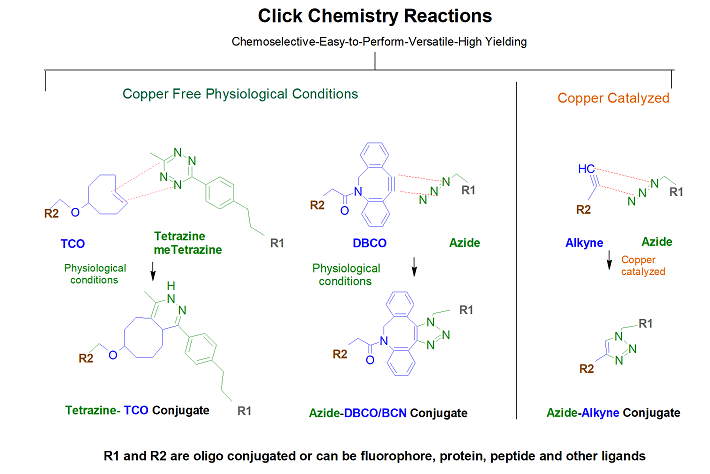.png)
Modification : Alkyne-C2 N
Catalog Reference Number
Category
Modification Code
5 Prime
3 Prime
Internal
Molecular Weight (mw)
Extinction Coeficient (ec)
Technical Info (pdf)
Absorbance MAX
Emission MAX
Absorbance EC
26-6924
Click Chemistry
[Alk-C2-N]
Y
Y
Y
302.11
-
PS26-6924.pdf
-
-
-
| Catalog No | Scale | Price |
| 26-6924-05 | 50 nmol | $200.00 |
| 26-6924-02 | 200 nmol | $200.00 |
| 26-6924-01 | 1 umol | $297.00 |
| 26-6924-03 | 2 umol | $340.00 |
| 26-6924-06 | 5 umol | $1,336.50 |
| 26-6924-10 | 10 umol | $1,011.00 |
| 26-6924-15 | 15 umol | $1,264.00 |
Click here for a complete list of Click Chemistry Oligo Modifications
This modification is a post synthesis conjugation to a primary amino group thus an additional modification with an amino group is required. A C3, C6 or C12 amino group can be placed at the 5' or for the 3' end a C3 or C7 amino and for internal positions an amino modified base is used, e.g Amino dT C6.
Alkyne NHS ester can be used to incorporate an active alkyne onto the 5'or 3' end of an oligonucleotide, as well as at an internal position. Incorporation of this modification to the oligo is done via conjugation to an active primary amine (such as Amino Linker C6). As a result, the alkyne group is separated from the oligo by a spacer arm of varying length, which serves to reduce steric interaction between the reactive group and the oligo. The presence of the alkyne allows the user to use Click Chemistry (a [3+2] cycloaddition reaction between alkynes and azides, using copper (I) iodide as a catalyst) to conjugate it to a variety of azide-containing labels/tags (e.g., fluorescent dyes, biotin, or oligos, with extremely high regioselectivity and efficiency (1,2). When conjugation to an azide-oligo is desired, preparation of the azide-oligo can be achieved using either an Azidobutyrate NHS Ester or the 5' Bromohexyl modifier (see their respective tech sheets for details). Click chemistry can be used to form short, cyclic oligos that can be used as research tools in various biophysical and biological studies (3). In particular, they have considerable potential for in vivo work, as cyclic oligos are known to be very stable in serum for up to several days.

References
1. Huisgen, R. Angew. Chem. Int. Ed. (1963), 2: 565-568.
2. Rostovtsev, V.V., Green, L.G., Fokin, V.V., Sharpless, K.B. A Stepwise Huisgen Cycloaddition Process: Copper(I)-Catalyzed Regioselective Ligation of Azides and Terminal Alkynes. Angew. Chem. Int. Ed. (2002), 41: 2596-2599.
3. Kumar, R., El-Sagheer, A., Tumpane, J., Lincoln, P., Wilhelmsson, L.M., Brown, T. Template-Directed Oligonucleotide Strand Ligation, Covalent Intramolecular DNA Circularization and Catenation Using Click Chemistry. J. Am. Chem. Soc. (2007), 129: 6859-6864.
- Alkyne-C2-(Propargyl-PEG1) NHS
